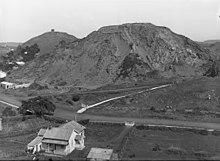Te Tātua a Riukiuta
| Te Tātua a Riukiuta | |
|---|---|
| Big King | |
 Te Tātua a Riukiuta from Ōwairaka / Te Ahi-kā-a-Rakataura / Mt Albert | |
| Highest point | |
| Elevation | 133 m (436 ft) |
| Coordinates | 36°54′11″S 174°45′17″E / 36.902926°S 174.754651°E |
| Geography | |
| Location | Auckland, North Island, New Zealand |
| Parent range | Auckland volcanic field |
| Geology | |
| Volcanic arc/belt | Auckland volcanic field |
Te Tātua a Riukiuta / Big King is a volcano and Tūpuna Maunga (ancestral mountain) in Three Kings, New Zealand that erupted 28,500 years ago.[1] The volcano had three prominent peaks known as Three Kings and a number of smaller peaks until most of them were quarried away, leaving a sole remaining large peak known as Big King.
Geology
Te Tātua a Riukiuta was probably the most complex volcano in the Auckland volcanic field, consisting of five significant scoria cones and about a dozen smaller scoria mounds, sitting inside a large explosion crater. Along the edge of this crater to the south runs Mount Albert Road, and to the north, Landscape Road. At 800 metres (2,600 ft) across and nearly 200 metres (660 ft) deep, the explosion crater, which was caused by the initial eruption, was the largest in Auckland. The crater no longer exists today.[2][3] The three largest scoria cones of the group were Big King at 133 m (436 ft) high, East King at 120 m (390 ft) high, and Highest King, which was 135 m (443 ft) high.
Lava flows ran from here down a stream valley for three kilometres to
The eruption occurred 28,500 years ago. Charred twigs and wood were found in six
History


An earlier name for the volcano was Te Tatua o Mataaho (the war belt of
Te Tātua a Riukiuta was once the site of a
The area has been drastically quarried over the years for the red scoria it contains, and only one of the three large peaks (Te Tātua a Riukiuta / Big King) remains today, largely because of the water reservoir that was built on its summit at the beginning of the 20th century. The reservoir is below the hydraulic grade of the area and is hence maintained as an emergency supply reservoir only.[citation needed]
However, the large scoria deposits in the surrounding area are still being quarried. The groundwater level became a problem for the quarry in 1995, and Winstone Aggregates, the company operating the quarry, arranged with the Auckland City Council to supply the water to the region. However, as a result of local opposition to this arrangement, the water is instead discarded into the sea. This dewatering has led to concerns about subsidence.[citation needed]
Treaty settlement
In the 2014
References
- ^ S2CID 129707270.
- ^ ISBN 978-1-86940-479-6.
- ^ a b "Te Tātua a Riukiuta". www.maunga.nz. Retrieved 2022-07-19.
- ^ "Story: Tāmaki tribes Page 1 – Tribal history and places". Te Ara. Retrieved 1 November 2014.
- ISBN 9780143018896.
- ISBN 978-0-908320-17-2. Retrieved 15 May 2022.
- ^ "Ngā Mana Whenua o Tāmaki Makaurau Collective Redress Act 2014 No 52 (as at 12 April 2022), Public Act – New Zealand Legislation". www.legislation.govt.nz. Retrieved 2022-07-17.
- ^ Dearnaley, Mathew (27 September 2014). "Volcanic cones regain Maori names". The New Zealand Herald. Retrieved 25 October 2014.
- ^ "NZGB decisions - September 2014". Land Information New Zealand. Archived from the original on 29 October 2014. Retrieved 25 October 2014.
- ^ Council, Auckland. "Tūpuna Maunga significance and history". Auckland Council. Retrieved 2022-07-17.
- Volcanoes of Auckland: A Field Guide. Hayward, B.W.; Auckland University Press, 2019, 335 pp. ISBN 0-582-71784-1.
External links
- Watercolour of Te Tātua-a-Riukiuta 1875 by Toi o Tāmaki
- View of the pā site c. 1904 in the collections of Te Papa Tongarewa
- Photographs of Te Tātua-a-Riukiuta held in Auckland Libraries' heritage collections
- Photographs of Te Tātua-a-Riukiuta in the collections of Auckland War Memorial Museum Tāmaki Paenga Hira

